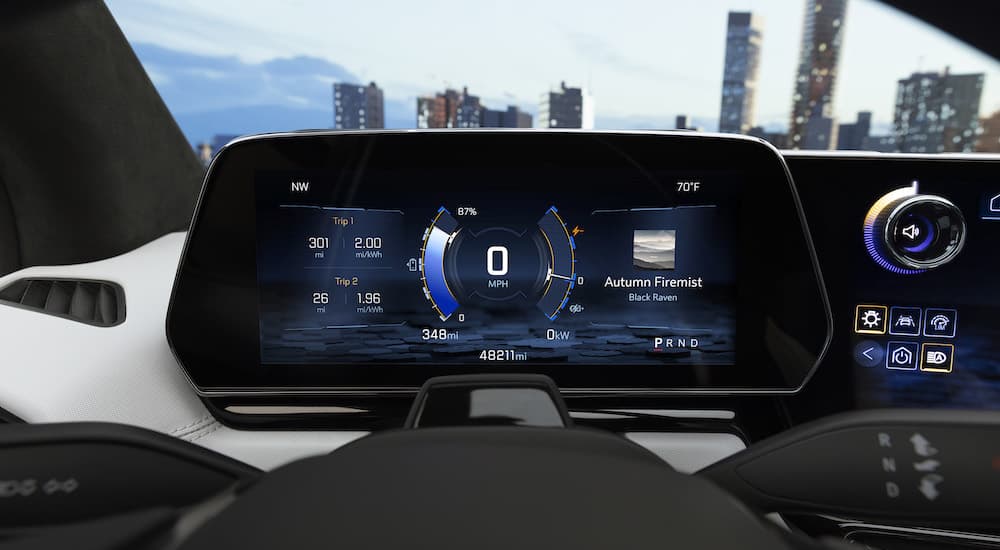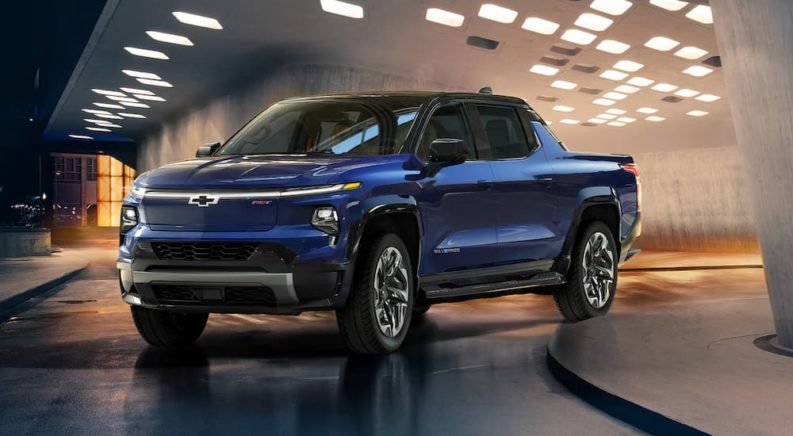With new technology comes a whole lot of new technical jargon, and EVs are no different. This wasn’t so much of an issue back in the days when there were only a few electric and hybrid vehicles on the market, but as their ranks expand and automakers steadily introduce a wider range of EV models, being able to speak the language of EVs is more important than ever. The 2024 Chevy Silverado EV presents a good excuse for a little impromptu study session as traditional pickup drivers flock to some intriguing new offerings.
There was a time when listening to your dad curse under the hood used to provide a good base of knowledge for aspiring gearheads, but today’s EVs have introduced a host of new terms and concepts torn straight from the pages of an electrical engineering textbook. This presents a real problem for drivers looking to make the jump from the familiar internal combustion engine (ICE) to the brave new world of electric vehicles as comparing the two can be like apples and oranges.
Any attempt raises some interesting questions, like how do you measure fuel efficiency in a vehicle that doesn’t use liquid fuel? How does horsepower work in electric motors? And how exactly is range measured? Such comparisons are a little difficult without first unpacking some of the concepts unique to the electric setup. Since these two systems use entirely different energy sources and propulsion methods, many of the familiar terms are a little imprecise when applied to EVs, but there are ICE-based comparisons for nearly every aspect of EVs. Read on and see how this new technology is poised to supplant the gas engine of old.
Motor vs Engine
For the uninitiated, it’s tempting to compare an EV’s electric motor to a gas-powered vehicle’s engine, but that won’t get you very far. The two terms are often used interchangeably by the less mechanically inclined but are fairly distinct in reality. While the net result of the two is the same–propelling your vehicle forward–they use two different methods to achieve it. An ICE engine uses liquid fuel to convert thermal energy into mechanical energy, which is routed through a multi-speed transmission that turns the driveshaft and, ultimately, the wheels themselves. While it sounds like a fairly straightforward process, ICE engines require hundreds of parts working in perfect harmony to get the job done.
EV motors are a little easier to wrap your mind around: they use large lithium-ion batteries to drive anywhere between one and four electric motors. Like any motor, the ones found in EVs convert energy–in this case, electrical energy–into mechanical energy. If you want to really tie your brain in some knots, remember that all engines are technically a specific subset of motors, but not all motors are engines. Again, these are often used interchangeably, but for our purposes, the term “engine” will be used to describe those that use liquid fuel to achieve their ends.
In an EV, DC electrical power from a lithium-ion battery is fed through an inverter, which converts it to AC power to directly drive between the electric motors. Instead of increasing the supply of gas being fed to the engine, pressing the accelerator on an EV adjusts the frequency of the AC power routed into the motor. There’s also no multi-speed transmission to cycle through here: EVs provide instantaneous power across a much wider powerband, eliminating the need for a complicated gearbox and supplying comparable oomph while using 90 percent fewer components. The hundreds of moving parts from the ICE drivetrain are nowhere to be found here, with some EVs getting by on as little as 17 distinct components. That’s a whole lot fewer parts than can break, adding to the EV’s already considerable value proposition.

MPG vs MPGe
The main advantage of EVs comes down to their use of electricity over fuel, but how much more efficient is it, exactly? Since the “miles per gallon” concept doesn’t really apply to an EV, it can be difficult for a driver to measure the cost savings associated with going electric objectively. One trap to avoid is confusing an EV’s range for its efficiency. A vehicle with a 100 kWh battery is likely going to have a greater range than one with a 60 kWh battery, even if the vehicle with the larger battery isn’t as efficient.
When it comes to electric vehicles, there are a couple of ways to measure efficiency, but first, some background. An EV’s battery capacity is measured in kilowatt-hours (kWh), with batteries typically ranging between 50 kWh up to 200 kWh on new electric pickups like the 2024 Silverado EV. Since an EV usually needs around 20-30 kilowatts to operate, a 60 kWh battery would give drivers somewhere in the neighborhood of three hours of travel time.
To simplify things, the EPA has come up with a handy formula to determine an EV’s miles-per-gallon equivalent (MPGe). The agency has determined that one gallon of gasoline is equivalent to 33.7 kWh of electricity, meaning that if it takes an EV 100 miles to expend 33.7 kWh, it will get 100 MPGe. This not only helps drivers to more easily compare the efficiency of different EVs, but goes a long way in demonstrating just how much more efficient they are than their fossil fuel counterparts. While MPGe varies between different types and sizes of EVs, it typically falls somewhere between 100 and 120 MPGe, though some high-end sporty EVs may be as low as 70 MPGe.
Of course, other factors come into play here as well. The larger and heavier the vehicle, the more kilowatts it’ll take to get it moving, so if a vehicle is particularly hefty or loaded down with passengers and cargo, expect decreased range. Just as with ICE engines, less aggressive driving also tends to improve overall efficiency, so those prone to a lead foot who see every green light as an opportunity for an impromptu race will see diminished efficiency. Again, this is nothing startling, as even newfangled EVs can’t escape the basic laws of physics.
There is one area where EVs differ from ICE vehicles in their fuel efficiency, and that’s temperature. Batteries tend to be uniquely susceptible to temperature extremes due to their chemical composition, with excessively hot or cold weather taking a noticeable toll on performance. Batteries simply don’t operate as efficiently at either end of the thermometer, with some studies suggesting that overall range could decrease by as much as 30 percent in freezing temperatures. This varies between makes and models, but even the hardiest batteries see at least a 5-10 percent loss of range below 32 degrees.
Warmer temperatures don’t take nearly as much of a toll, but there is still some effect, especially once one factors in the energy being siphoned off to run the vehicle’s HVAC system. Studies have said that an EV operating in ambient temps of 95 degrees and above while running AC could lose as much as 17 percent of its range. This HVAC conundrum is even more pronounced in cold temperatures since, unlike ICE vehicles, EVs can’t harvest excess engine heat to warm the cabin and must draw power directly from the battery to run a separate heating unit, reducing the range by as much as 40 percent. This is an important consideration to keep in mind for any EV drivers looking to make longer trips in winter weather, as your 200-mile range could now be nearly halved. However, the use of heat pumps in the latest EVs has mitigated these HVAC losses.
Battery Capacity vs Fuel Capacity
In terms of actual energy capacity for EV batteries, auto manufacturers aren’t making things any easier for the confused consumer. With gas-powered vehicles, it’s a fairly simple formula: a gas tank has a set volume that can hold a certain number of gallons. While your vehicle’s energy efficiency might decrease over time due to worn parts and spotty maintenance, that tank will always hold the same amount of fuel. Not so with EVs.
Manufacturers often advertise an electric vehicle’s gross (total) battery capacity, but this number actually represents how much energy a battery can theoretically hold, not how much it actually holds. There’s a reason for this beyond murky marketing: since draining a battery to zero percent or filling it to 100% will reduce its life, designers build in a little wiggle room to ensure that it never comes to that. Subtract that margin from the gross battery capacity, and you have an EV’s net (usable) capacity, which is a far more relevant figure when it comes to comparing EVs. Some manufacturers might try to pad their numbers by posting the higher gross capacity, but since drivers will never actually tap into that reserve, it doesn’t truly represent the battery’s functional capacity.
Whether you’re talking net or gross, this capacity will decrease over the course of thousands of charging cycles regardless of how well a battery is cared for. While it can take years to see the difference, it’s an inevitable part of the battery’s chemistry. But don’t worry too much. Federal regulations require manufacturers to warranty all EV batteries for at least 8 years/100,000 miles, and there are plenty of EVs that have racked up six-figure mileage and are still going strong.
With replacement batteries going for around $150 per kWh, drivers would be looking at a $5,000 bill for an entirely new 33 kWh battery, so proper charging habits become particularly important. As any smartphone user knows, letting your battery routinely drain itself to the point where your device shuts off is not ideal. Conversely, neither is keeping it 100 percent charged and plugged in at all times. Much like with smartphones, the ideal charging cycle for an EV ranges from 20 percent to 80 percent. Ensuring that it never charges above or below those two numbers will keep the battery at optimal health and maximize its service life, as will using Level 1 and Level 2 chargers rather than high-voltage DC fast chargers.

Horsepower and Torque
Horsepower is usually one of the most-cited specs for any modern ICE vehicle, but can be difficult to even locate in the fine print of some EV models. This might seem odd at first and give drivers the impression that EVs are inherently less powerful than ICE competitors, but the main reason for this is that, owing to the inherent efficiency of electric motors, horsepower isn’t nearly as important for electric vehicles. While slick car commercials have conditioned us to conflate horsepower with raw performance, the formula is actually a little more subtle when it comes to EVs. Case in point: some sportier EV coupes can match acceleration with legendary speed demons like a Corvette Z06 despite having only half as much horsepower under the hood.
It all comes down to a fundamental misunderstanding of how horsepower actually works. The advertised horsepower of an ICE engine is actually only achieved at a certain engine speed. The only problem is it can take a while for ICE engines to reach that magical RPM number, with the engine needing to ramp up to unleash its true potential. This is also one reason why ICE engines have multi-speed transmissions: they’re able to maximize power output at different engine speeds, so drivers don’t have to push the gas pedal through the floor to get up to cruising speed.
With EVs, that build-up of speed is a thing of the past. The electric motors found on EVs deliver all the horsepower the vehicle can produce the moment you step on the “gas” pedal. Using a single-speed transmission, EVs shuttle this power to the wheels almost instantaneously and provide a level of acceleration that would put most ICE sports cars to shame. This method is not only far more efficient than the gradual ICE process, but has the welcomed side effect of producing unprecedented torque. This is particularly useful when it comes to towing and hauling with pickups like the 2023 Silverado EV. Chevy has made the most of the EV pickup’s considerable torque, offering a selectable Wide Open Watts (WOW) mode, which will allow drivers to launch the Silverado off the starting line quick enough to do zero to 60 in a hair-raising 4.5 seconds.
Different Can Be Exciting
EVs represent an exciting new trend in the automotive world, but they require drivers to do a little more research than they might with old-fashioned ICE vehicles. The benefits are well worth the study time, with EVs offering unparalleled efficiency and savings, not to mention considerable environmental advantages. As the infrastructure continues to grow around EVs, they’re becoming a more practical choice than ever, with charging stations now approaching the critical mass necessary to make EVs a convenient alternative to gas-powered vehicles.
Advancements in battery technology have seen marked improvements in both cost and efficiency in the last decade, lowering prices and opening up the EV market to entirely new sectors of the market. At the same time, the new breed of EVs like the 2024 Chevy Silverado EV offers an exciting glimpse at the future, proving that even one of the country’s most beloved pickups can go through the EV redesign and emerge as the same hardy, work-ready truck it’s always been. This is an encouraging sign for the future of the EV market, which will only continue to grow as EVs improve and become an even more practical option.

